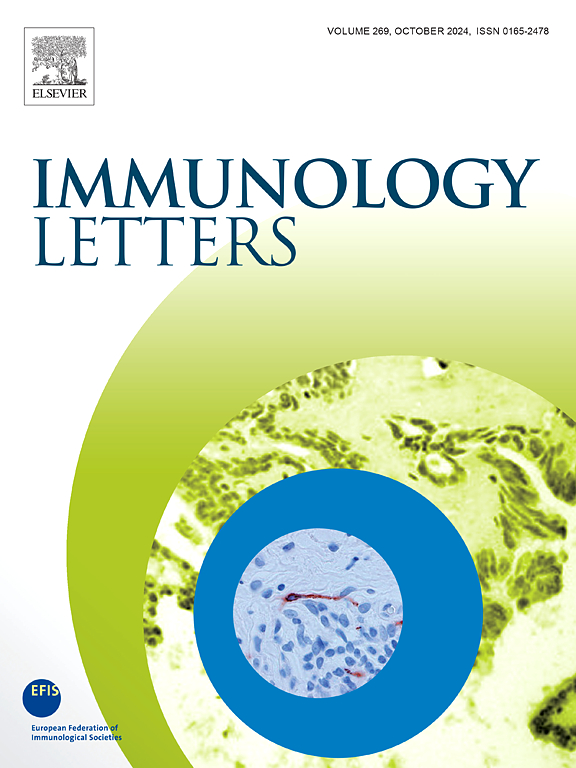阿奇霉素对烟曲霉侵染J774小鼠巨噬细胞作用的体外分析:阿奇霉素提高巨噬细胞对烟曲霉的应答。
IF 2.8
4区 医学
Q3 IMMUNOLOGY
引用次数: 0
摘要
背景:慢性肺部疾病患者常发生由烟曲霉(Aspergillus fumigatus, AF)引起的肺曲霉病。肺泡巨噬细胞在AF的初始免疫反应中起关键作用。阿奇霉素(AZM),通常以其减少急性加重和改善肺功能的免疫调节特性而闻名,对曲霉病的发展有不同的影响。虽然一些研究表明AZM有助于AF定植的患者,但其他研究表明AF定植率增加。目的:考虑到AZM对宿主对其他病原体的积极影响,我们假设AZM可能通过调节巨噬细胞功能来改善AF的免疫反应。研究AZM对J774小鼠巨噬细胞对烟曲霉反应的体外影响。方法:将小鼠巨噬细胞系J774极化为不同的表型:(1)经典M1巨噬细胞,由干扰素-γ (IFN-γ)和脂多糖(LPS)产生;(2)阿奇霉素处理M1巨噬细胞(以下简称M1A巨噬细胞),由阿奇霉素除IFN-γ和LPS外处理M1细胞产生;(3)交替激活M2巨噬细胞,由白细胞介素-4 (IL-4)、白细胞介素-13 (IL-13)和LPS产生。然后分析这些极化巨噬细胞的细胞因子产生,真菌杀灭能力和活性氧(ROS)的产生。结果:我们观察到azm处理组巨噬细胞表型向抗炎样谱转变,其特征是与M1和m2极化组相比,真菌杀伤增加。这伴随着白细胞介素-6 (IL-6)细胞因子产生的减少,精氨酸酶活性的增加,而ROS生成没有任何显著变化。进一步的实验证实,观察到的真菌清除率的增加归因于AZM对巨噬细胞的影响,而不是对烟曲霉的任何直接抗真菌活性。结论:AZM可增强巨噬细胞功能,增强抗炎反应,提高真菌清除能力。本文章由计算机程序翻译,如有差异,请以英文原文为准。

In vitro analysis of azithromycin’s effect on J774 murine macrophages challenged with Aspergillus fumigatus
Background
Patients with chronic lung diseases often suffer from pulmonary aspergillosis, caused by Aspergillus fumigatus (AF). Alveolar macrophages play a key role in the initial immune response to AF. Azithromycin (AZM), commonly known for its immunomodulatory properties in reducing exacerbations and improving lung function, has mixed effects on the development of aspergillosis. While some studies suggest AZM aids AF-colonized patients, others indicate increased rates of AF colonization.
Objective
Given AZM's positive impact on host response to other pathogens, we hypothesized that it would improve immune responses to AF by modulating macrophage function. We investigated the in vitro effect of AZM on J774 murine macrophage response to Aspergillus fumigatus.
Method
The murine macrophage cell line J774 was polarized into distinct phenotypes: (1) classical M1 macrophages, generated using interferon-gamma (IFN-γ) and lipopolysaccharide (LPS); (2) azithromycin-treated M1 macrophages (hereafter referred to as M1A macrophages), generated by treating M1 cells with azithromycin in addition to IFN-γ and LPS; and (3) alternatively activated M2 macrophages, generated using interleukin-4 (IL-4), interleukin-13 (IL-13), and LPS. These polarized macrophages were then analyzed for cytokine production, fungal killing capacity, and reactive oxygen species (ROS) generation.
Results
We observed a shift in macrophage phenotype toward an anti-inflammatory-like profile in the AZM-treated group, characterized by an increased fungal killing compared to both M1- and M2-polarized groups. This was accompanied by a reduction in interleukin-6 (IL-6) cytokine production, an increase in arginase activity, without any significant change in ROS generation. Further assays confirmed that the observed increase in fungal clearance was attributable to AZM’s impact on macrophages rather than any direct antifungal activity against Aspergillus fumigatus.
Conclusion
These findings suggest AZM enhances macrophage function, boosting anti-inflammatory responses and improving fungal clearance.
求助全文
通过发布文献求助,成功后即可免费获取论文全文。
去求助
来源期刊

Immunology letters
医学-免疫学
CiteScore
7.60
自引率
0.00%
发文量
86
审稿时长
44 days
期刊介绍:
Immunology Letters provides a vehicle for the speedy publication of experimental papers, (mini)Reviews and Letters to the Editor addressing all aspects of molecular and cellular immunology. The essential criteria for publication will be clarity, experimental soundness and novelty. Results contradictory to current accepted thinking or ideas divergent from actual dogmas will be considered for publication provided that they are based on solid experimental findings.
Preference will be given to papers of immediate importance to other investigators, either by their experimental data, new ideas or new methodology. Scientific correspondence to the Editor-in-Chief related to the published papers may also be accepted provided that they are short and scientifically relevant to the papers mentioned, in order to provide a continuing forum for discussion.
 求助内容:
求助内容: 应助结果提醒方式:
应助结果提醒方式:


